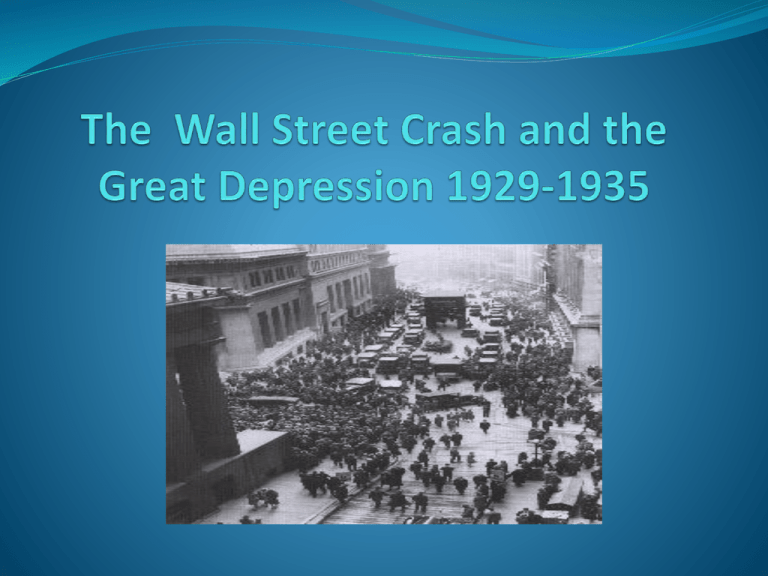The Great Depression 1929-1935
advertisement

The Roaring Twenties were a time of wealth and excess Stock prices had reached what seemed like a permanently high plateau On ‘Black Thursday’ October 24 1929 that all changed Share prices on the New York Stock Exchange (NYSE) collapsed and continued to fall rapidly for a month, beginning the a chain of events that led to the Great Depression Banks collapse, unemployment and prices rise – FINANCIAL ARMAGEDDON The countries that had relied on America’s economic prosperity to stay afloat were now exposed to its economic collapse A Vicious Cycle Crash follows a speculative boom – basically that means there’s no guarantee you’ll get you r money back – in the late 1920s. Hundreds of thousands of Americans are investing heavily in the stock market and many of them are borrowing a lot of money to do so. Over $8.5b was out on loan, more than the entire amount of currency circulating in America at that time. Stock prices continued to rise and people continued to invest thinking the rise would never end, but, of course, it would. A Vicious Cycle Investors stood to lose a lot if the market turned down. Prices fell by 17% in the six weeks to Black Tuesday, but then recovered again. However, on October 24, they began to drop dramatically and what followed was a massive amount of panic selling, where people tried to get rid of their shares (12.9 million in total) This led to the market crash, and a loss of $14 billion People then tried to withdraw their money from the banks, much of which was tied up in other investments, so the banks began to fall over as well A Vicious Cycle Less banks, less lending, hence more difficult for companies to borrow capital to make investments for new projects and expansions. Business uncertainty creates job uncertainty, creates bankruptcy If you don’t have a job or your job is under threat you’re not going to spend as much money, so the economy suffers. And, finally, those who have relied on America; the Germans, French and British start to suffer economic collapse as well. American overseas loans Canada $936m Latin America $1421m Europe $2815m Asia Pacific $586m Total $5758m Military solutions to economic Problems Rise of dictatorship Extremists Germany •Social Democrat majority blamed for everything •Legacy of Treaty of Versailles and reparations •Fear of communist uprising •The rise of Hitler and the blame game. Japan • Export prices for silk fall 50%, by 1931 half of factories lie idle • Conscription of the unemployed • Conquer other countries to make them captive markets for Japanese goods • Invasion of Manchuria 1931 • Rise of fascism • Parties allied to army begin to assassinate politicians United States • Continued policy of isolationism to cut costs and commitments • Unemployment peaks at 25% in 1933 • 5000 banks fail • Political realignment brings Franklin Roosevelt to power in 1932 • Cheap entertainment to help people forget their woes. Big band and jazz music, Walt Disney, radio shows. European powers Italy Mussolini looks for national distractions and blames the communists for the mess Russia Apparent immunity to the recession, “validating” the theory of Marxism Claim world revolution is at hand. What might that mean? Britain and France 20% of insured workforce unemployed in UK Greatly weakened, fear of communist revolts Cut backs in government spending, even on defence, hence less prepared for war, or to help each other. Rise of the socialist Popular Front in France Great Depression cartoons What is going on here? Legacy • Rise of fascism in Germany, Italy and Japan • Rise of Josef Stalin in Russia • Increase in popularity of extreme left wing parties and socialism • Conflict and invasion











